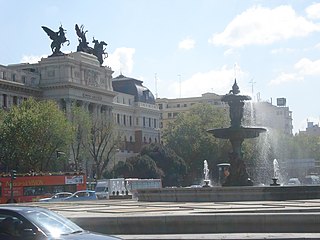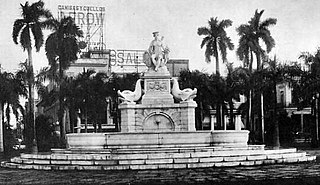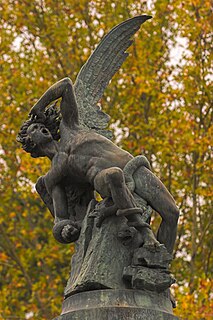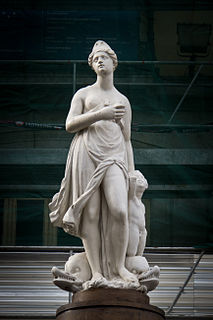
The Royal Palace of Madrid is the official residence of the Spanish royal family at the city of Madrid, although now only used for state ceremonies. The palace has 135,000 square metres (1,450,000 sq ft) of floor space and contains 3,418 rooms. It is the largest functioning royal palace and the largest by floor area in Europe.

Paseo de Recoletos is a wide boulevard in central Madrid leading from Plaza de Cibeles to Plaza de Colón.

Plaza Las Delicias is the main plaza in the city of Ponce, Puerto Rico. The square is notable for its fountains and for the various monuments it contains. The historic Parque de Bombas and Ponce Cathedral buildings are located within the plaza, which actually consists of two squares: Plaza Muñoz Rivera on the north end, and Plaza Degetau on the southern end. The square is the center of the Ponce Historic Zone, and it is flanked by the historic Ponce City Hall to the south, the early 19th-century Teatro Fox Delicias to the north, the NRHP-listed Banco Crédito y Ahorro Ponceño and Banco de Ponce buildings to the east, and the Armstrong-Poventud Residence to the west. The square dates back to the early Spanish settlement in Ponce of 1670. It is the main tourist attraction of the city, receiving about a quarter of a million visitors per year.

Agustí Querol i Subirats was a prominent Spanish sculptor, born in Tortosa, Catalonia.

Gregorio Fernández was a Spanish Baroque sculptor. He belongs to the Castilian school of sculpture, following the style of other great artists like Alonso Berruguete, Juan de Juni, Pompeyo Leoni and Juan de Arfe.

Perales de Tajuña is a small town in Spain, in the province and autonomous community of Madrid, located about 40 km to the southeast of Madrid in the area known as the Comarca de Las Vegas. The municipality covers 48.92 km2, has a population of 2,738 inhabitants and a population density of 55.97 inhabitants/km2. To the north it borders with Arganda del Rey and Campo Real, to the east with Tielmes, to the south with Villarejo de Salvanés, and to the west with Morata de Tajuña and Valdelaguna.

Plaza del Emperador Carlos V is a square in the city of Madrid. It is named after Charles V, Holy Roman Emperor, who also reigned in Spain as Charles I. However, it is referred to as Plaza de Atocha, because it is where Madrid Atocha railway station is located.

Plaza Degetau, formally Plaza Federico Degetau, is the larger of two plazas at Plaza Las Delicias, the main city square in the city of Ponce, Puerto Rico. The other plaza is named Plaza Muñoz Rivera and is located north of Plaza Degetau. The square is notable for its fountains and for the various monuments it contains. The historic Parque de Bombas and Ponce Cathedral buildings are located bordering the north side of this plaza. The square is the center of the Ponce Historic Zone, and it is flanked by the historic Ponce City Hall to the south, the Cathedral and historic firehouse to the north, the NRHP-listed Banco Crédito y Ahorro Ponceño and Banco de Ponce buildings to the east, and the Armstrong-Poventud Residence to the west. The square dates back to the early Spanish settlement in Ponce of 1670. It is the main tourist attraction of the city, receiving about a quarter of a million visitors per year.

Pedro de Ribera was a Spanish architect of the Baroque period.

Fuente de la India is a fountain by Giuseppe Gaggini in Havana, Cuba, at the south extreme of Paseo del Prado, about 100 m south of El Capitolio, between Monte and Dragones Streets. The figure represents the Indian woman "Habana" in whose honor Havana was named.

The fountain of Cibeles in Mexico City is a bronze replica of the fountain located in the Plaza de Cibeles in Madrid that was built during the reign of Charles III by architect Ventura Rodríguez between 1777 and 1792. The Mexican version is located at a traffic circle in Plaza Villa de Madrid, where Oaxaca, Durango, Medellín and El Oro streets converge in Colonia Roma.

The Fuente del Ángel Caído is a fountain located in the Buen Retiro Park in Madrid, Spain.

The architecture of Madrid has preserved the look and feel of many of its historic neighbourhoods and streets, even though Madrid possesses a modern infrastructure. Its landmarks include the Royal Palace of Madrid; the Royal Theatre with its restored 1850 Opera House; the Buen Retiro Park, founded in 1631; the 19th-century National Library building containing some of Spain's historical archives; a large number of national museums, and the Golden Triangle of Art, located along the Paseo del Prado and comprising three art museums: Prado Museum, the Reina Sofía Museum, a museum of modern art, and the Thyssen-Bornemisza Museum, which completes the shortcomings of the other two museums. Cibeles Palace and Fountain have become the monument symbol of the city.

The Fountain of la Abundancia or Fuente de la Abundancia, was located in the Plaza de la Cebada (Madrid), for this plaza also was known by this name. It are preserved several architectural elements and various coats of arms, which were saved its demolition that took place in the 19th century, to be integrated into a new structure.
The Fuente de las Ranas is an emblematic fountain located in center of the Spanish city of Albacete. Built in memory of Dionisio Guardiola, was inaugurated in 1916 in the center of the current Plaza de Gabriel Lodares, having chaired several places in the city until, in 2007, it was moved to its current location, the roundabout between the Paseo de la Libertad, the Avenida de la Estación, the Paseo de la Cuba and Calle Alcalde Conangla.

Las Danaides is a fountain and sculpture in Mexico City's Alameda Central, in Mexico. The statue depicts two women representing the 50 daughters of Danaus (Danaïdes).

La Primavera is an outdoor fountain and sculpture installed in Mexico City's Alameda Central, in Mexico. The statue represents Persephone.























